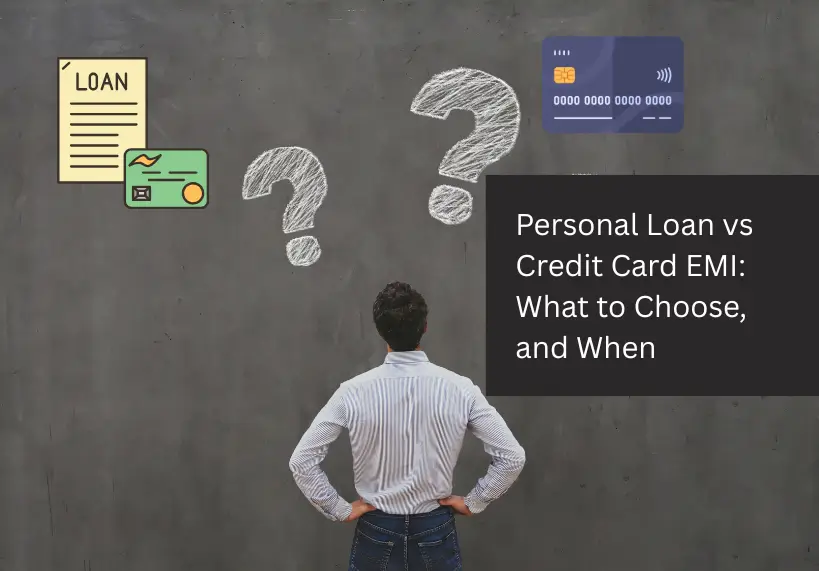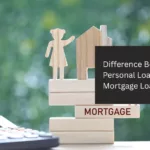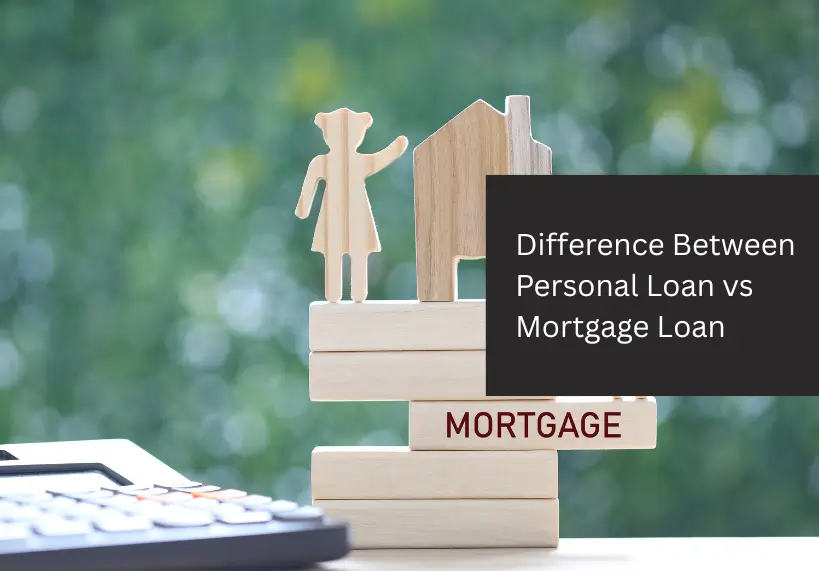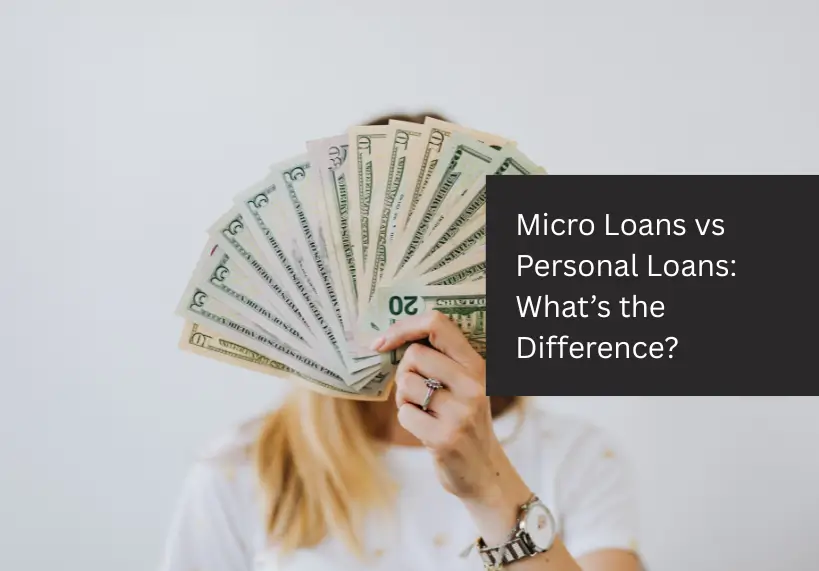
When sudden expenses come up, borrowing wisely can help you stay stress-free. Both personal loans and credit card EMIs make it easier to handle big costs without emptying your savings. But picking the right option can be confusing. In this guide, we’ll simply explain the difference between personal loan vs credit card EMI, when to use each, and how to choose what works best for you.
What is a Personal Loan EMI?
A personal loan EMI is a fixed monthly payment you make to repay a lump-sum loan borrowed from a bank or lender. It includes both the principal and interest, spread evenly over a pre-decided tenure, usually between 12 and 60 months.
Personal loans are unsecured, meaning you don’t have to pledge collateral like property or gold. You can use them for almost anything, from home renovation and wedding expenses to debt consolidation or medical bills.
Because the interest rate and tenure are fixed, you get predictable repayments and better control over your budget. However, approval depends on your credit score, income, and repayment history.
What is a Credit Card EMI?
A credit card EMI allows you to convert your purchases into easy monthly installments. Instead of paying the full amount upfront, you repay in smaller amounts over a chosen tenure, usually between 3 to 24 months.
For instance, if you buy a laptop for ₹60,000, your bank can convert it into a credit card EMI plan where you pay ₹5,000–₹6,000 per month. The interest rate on credit card EMIs is usually higher than on personal loans, but the process is instant, no paperwork, no waiting.
It’s a great option for short-term needs, especially if you already have an active credit card and want quick, convenient financing.
Difference Between Personal Loan and Credit Card EMI
Let’s compare personal loan vs credit card EMI side-by-side to understand which suits you better:
Key Takeaways:
| Feature | Personal Loan | Credit Card EMI |
| Approval Time | 24–48 hours after verification | Instant for existing cardholders |
| Interest Rate | 9.9% to mid-20s% p.a., depending on lender & credit profile. | 14%–24% per annum |
| Loan Amount | Higher (₹50,000 to ₹25 lakhs) | Limited to your card limit |
| Tenure | 1–5 years | 3–24 months |
| Processing Fee | ~0.5%–2.5% (some lenders charge flat min/max fees) | Often zero or minimal |
| Documentation | Requires income proof and KYC | None (already verified) |
| Flexibility | Fixed monthly payments | Can be converted purchase-wise |
| Ideal For | Big planned expenses | Smaller, urgent purchases |
- A personal loan is ideal for long-term or high-value needs like home renovation, higher education, or medical treatment.
- A credit card EMI is better for short-term purchases or emergencies when you want instant approval.
- In most cases, personal loans offer lower interest rates than credit card EMIs, making them more affordable for large expenses.
- When comparing offers, always check the personal loan interest rate, even a small difference can significantly reduce your total repayment cost.
- A credit card EMI gives convenience and speed, though it might cost slightly more overall.
Ultimately, the choice in personal loan vs credit card EMI depends on your loan amount, urgency, and repayment comfort.
When is Credit Card and Personal Loan Option Better?
Choosing between a credit card EMI and a personal loan depends on your financial situation and the type of expense. Let’s look at when each option makes more sense.
When a Credit Card EMI Works Better
- For smaller purchases: Ideal for buying electronics, appliances, or travel tickets.
- Quick approval: If you need instant financing without paperwork.
- Promotional offers: Many banks offer zero or low-interest EMIs for specific products.
- Short-term repayment: Perfect if you can repay within a year or two.
Example: You want to buy a new smartphone worth ₹70,000. Instead of paying upfront, you can convert it into a 12-month EMI at a reasonable rate using your existing credit card, no hassle, no waiting.
Note: Converting a purchase to EMI typically blocks the full transaction amount against your credit limit until EMIs are billed – this can temporarily increase utilisation and affect credit metrics.
When a Personal Loan is the Smarter Choice
- For large expenses: Such as medical bills, home renovation, or debt consolidation.
- Longer repayment period: Manageable EMIs spread over up to 5 years.
- Lower interest rates: Especially for salaried individuals with a good credit score.
- No credit limit restriction: Borrow more than your card allows.
Example: You need ₹5 lakhs for a wedding or to clear existing high-interest debt. A personal loan offers lower EMIs and flexible tenure, making repayment easier and more predictable.
In short, if speed matters, choose a credit card EMI. If affordability and larger funding matter, go for a personal loan.
Conclusion
Both personal loans and credit card EMIs are smart borrowing tools, but they serve different purposes. A personal loan works best for high-value, long-term expenses, while a credit card EMI is perfect for smaller, quick purchases.
Before deciding, compare interest rates, tenure, processing fees, and your repayment ability. If you’re planning a big expense or want to consolidate debt at a lower rate, it’s wise to apply for personal loan options that fit your needs. Remember, the smarter your choice in personal loan vs credit card EMI, the easier it becomes to stay financially stable and debt-free.
FAQs
Q1. Which is cheaper- a personal loan or credit card EMI?
A: Personal loans usually have lower interest rates than credit card EMIs, making them more affordable for larger or long-term borrowings.
Q2. Can I prepay my personal loan or credit card EMI?
A: Yes, most banks allow prepayment or foreclosure. However, check for any applicable charges before doing so.
Q3. Does converting purchases to EMI affect my credit score?
A: Not necessarily, as long as you make payments on time, your credit score remains healthy. Borrowing responsibly through trusted providers like LoanTap can even improve your credit history over time.
Q4. Which is faster, personal loan or credit card EMI?
A: Credit card EMIs are typically instant, while personal loans may take 24–48 hours after verification and approval.
Q5. How do I choose between personal loan vs credit card EMI?
A: If you need a quick, short-term fix for smaller purchases, go for a credit card EMI. For bigger or long-term expenses, a personal loan is the better option.
Q6: Are prepayment charges applicable?
A: Lenders’ policies differ; RBI issued updated prepayment guidance in 2025 – check your lender’s T&Cs before prepaying.








